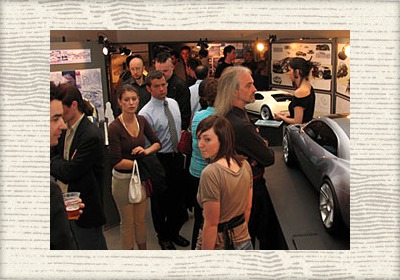College Exhibition: Coventry University Design Degree Show 2004
Wed, 01 Sep 2004Sep 1, 2004 - Final year undergraduate students from the Coventry University Transport Design course showed their work in the annual degree exhibition in June. The 2004 show celebrates the conclusion of either 3 or 4 years of study, depending on whether the BA Hons or MDes study routes have been followed.
With 35 graduating students on the MDes in Transport Design plus 15 graduates on either BA Automotive Design or Transport and Product Design, the show is the largest in Europe for transportation design graduates. The degree exhibition also featured work from the Consumer Product Design, Fine Art and Graphic Design courses.
Although final projects are individually selected, there were several emerging themes at this year's show including the influence of dance and sculpture in car design, the use of asymmetric design, and 1970's interiors and furniture. "This year sees the first wave of totally computer-literate graduates who have all studied Alias or other 3D modelling programs" explains Course Tutor Brian Clough. "There are fewer presentations of conventional flatwork now compared to previous years and a deeper thinking behind the transportation projects this year - not simply cars."
Allan Dransfield's 'Sonic City' was one of several projects based on an asymmetric form. The car was inspired by musical rhythms and forms and the research included filming dancers in a studio using Glo-sticks to capture their movements. These flowing forms are evident in the different lamp treatments for each side of the vehicle that, apparently, can still meet European legislation requirements.
Ben Urwin aimed to reinvent the poor image of mobile catering vans in future. His final asymmetric form was inspired by the works of Anish Kapoor and Santiago Calatrava and the design aims to interpret the sensuous qualities of H?agen-Dazs ice cream into a unique form language. The rear end opens and a row of customer seats concertina outwards, the aim being to position the vehicle as a premium product where the customer would wish to linger around, unlike current diesel vans.
David Hickman took the functional approach of Birkenstock footwear and applied to his design for a Volvo roadster. The simple, flat-iron wedge form features fold-down front seats and a suede tonneau cover, while the car itself is finished in 1970's style Scandinavian materials such as white oak veneer and tan nubuck.
Another street vehicle was Guy Melville-Brown's roadster for Gen Y. The project looks to maximise the potential of a static vehicle, allowing the user to interact with it as a piece of skate, street and social architecture. The body can be used as a skateboarding obstacle - a kind of 'Jack Ass' car - and the panels of the car are designed take on their own patina and graffiti, like a worn skateboard.
A different approach to an urban two-seater was displayed by Joel Bridge. His Fiat Aria 'Scooter Plus' concept is a crossover between a large scooter and a Smart-type city car and aims to slot in below the Panda in Fiat's line-up. The saddle-type seats give a high eyepoint for good vision in traffic, while the 400cc compressed air engine would allow 160km between charges - with absolutely zero emissions.
Craig Dent chose to design a compact BMW-Virgin brand motorcycle specifically for use by dispatch riders in cities. The bike is totally repackaged and can carry more than most large bikes yet the centre of gravity remains constant and doesn't shift depending on load. The Virgin brand aims to bring professionalism to the industry and lift the bad image that courier riders currently possess. The compact size would also extend its appeal for women riders.
By



